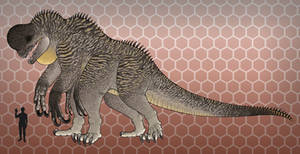Following the acquisition of InGen Incorporated by Masrani Global in 1998 and the revival of the 'Jurassic'-branded theme park in 2004, large scale production of biological assets was restarted on their remaining San Diego facilities. In early 2008, Simon Masrani began commission of more experimental work from InGen to produce transgenic organisms as part of a second wave of exhibits at the park, starting from the mid-2010s, and meant to boost revenue and begin expansion of the 'Jurassic World' parks into a franchise.
Most of these experiments were undertaken at Site C, a black site compound located on the Caribbean Island of Ile Saint-Hubert. InGen leased the island from the Government of Barbados in the early 1980s in exchange for producing genetically modified crop plants that could maximize yields in limited farm area. At the time of the original park's closure, InGen had been in the process of modifying their Ile Saint-Hubert facilities to begin large-scale cloning and maturation of biological assets in preparation for later expansion into a second park to be built the Bahamas during the early 2000s. Construction at Site C was nearly complete by the time Site A and Site B were abandoned in 1993, so refurbishing the complex and restarting work at the site was cost-effective. Although much of the island was simply used for maintaining surplus mainline stock that were still awaiting shipment to Isla Nublar, the main goals of the Site C facilities' research and development sector were to create artificial species.
The vast majority of early attempts at large-scale gene splicing were abject failures. The lucky ones died in vitro, while the unlucky ones survived just long enough to hatch. It was one thing to refill junk DNA sequences and rebuild an organism as closely to its original form as possible based on knowledge of closely related biotypes, it was another to intentionally rewrite large chunks of genome and still produce something that would grow and survive without countless lethal side-effects. InGen geneticists had succeeding in producing viable hybrids through splicing plant genes by the mid-1990s, but animals were another beast entirely. The first trial tests on modern animals succeeded with salamanders, while their first technical success using pre-historic DNA was Specimen E750, produced in 2009, although purely in that it survived to adulthood. This individual was widely marked off as a failure by InGen geneticists and Masrani executives, due to its grotesque appearance, extreme, self-destructive aggression, and metabolism instability that made longterm sturdiness unlikely.
More than simply producing a viable and mature transgenic organism, the goal was to produce "engineered entertainments"; something truly spectacular that would awe crowds of visitors more than what nature itself had already offered and was intended to form the future backbone of the 'Jurassic World' brand name, as they moved away from naturalistic creations that were difficult to trademark. For this undertaking, the base strain utilized in the largest scale gene splicing project on Site C was that of the greatest predator that ever lived. Many thousands of modified egg cells were synthesized. Hundreds could be induced to replicate. Dozens produced embryos. Seven survived to hatching. Only one survived to maturity.
Modification of the genes that controlled growth hormone expression allowed the specimen to achieve skeletal maturity at an accelerated rate. By early 2010, Specimen V.23.11, exceeded sixteen metres in length and was estimated at twenty tonnes in mass. From a purely scientific standpoint, this was a monumental achievement; they had succeeding in creating the largest carnivorous animal to ever walk on land, something so unlike what had ever lived, yet somehow remained healthy. However, from an aesthetic standpoint, it was undeniably malformed to an extreme degree. Such large-scale splicing had produced unexpectedly chaotic side-effects in Hox gene expression, the modification of growth hormone production resulted in paedomorphic body features and underdeveloped mental faculties, despite reaching physical maturity, and excess addition of secondary gene sources (primarily avian and lissamphibian) had rendered the animal nearly unrecognizable from its base form.
The Masrani Global board of directors responded negatively to this aberration, deeming it completely unfit for public display due to its obvious deformities, in spite of reduced aggression and metabolic stability, resulting in its indefinite quarantine on Site C, alongside other surviving transgenic organisms which had also been rejected from exhibition on Isla Nublar for similar unacceptable physical or behavioural abnormalities that rendered them unmarketable. However, Site C would be completely abandoned by late 2010, due to a critical software error resulting in the automated security systems going offline, allowing for the escape of several dangerous assets, including Specimen V.23.11. Following the incident, Masrani Global would relocate further development of transgenic assets on-site at the park, with development beginning anew on another hybrid species in early 2012.
Despite its abandonment, Ile Saint-Hubert was used as a dumping ground for rejected creations up until Jurassic World's final closure in 2015, and InGen continued remote monitoring of Site C through drone flyovers and Mascom satellite imagery up until the company's dissolution in mid-2025, whereupon the files pertaining to their undisclosed transgenic experimentations on Ile Saint-Hubert were publicly released. The last sighting of Specimen V.23.11, occurring only six weeks prior to InGen's final closure indicates longterm sustained survival in an unregulated environment. A rather miraculous development, as the animal was never intended to remain healthy outside controlled supervision. In the end, against all odds... life found its way.
----
This post could be seen months earlier on Patreon; consider subscribing if you like my content!
